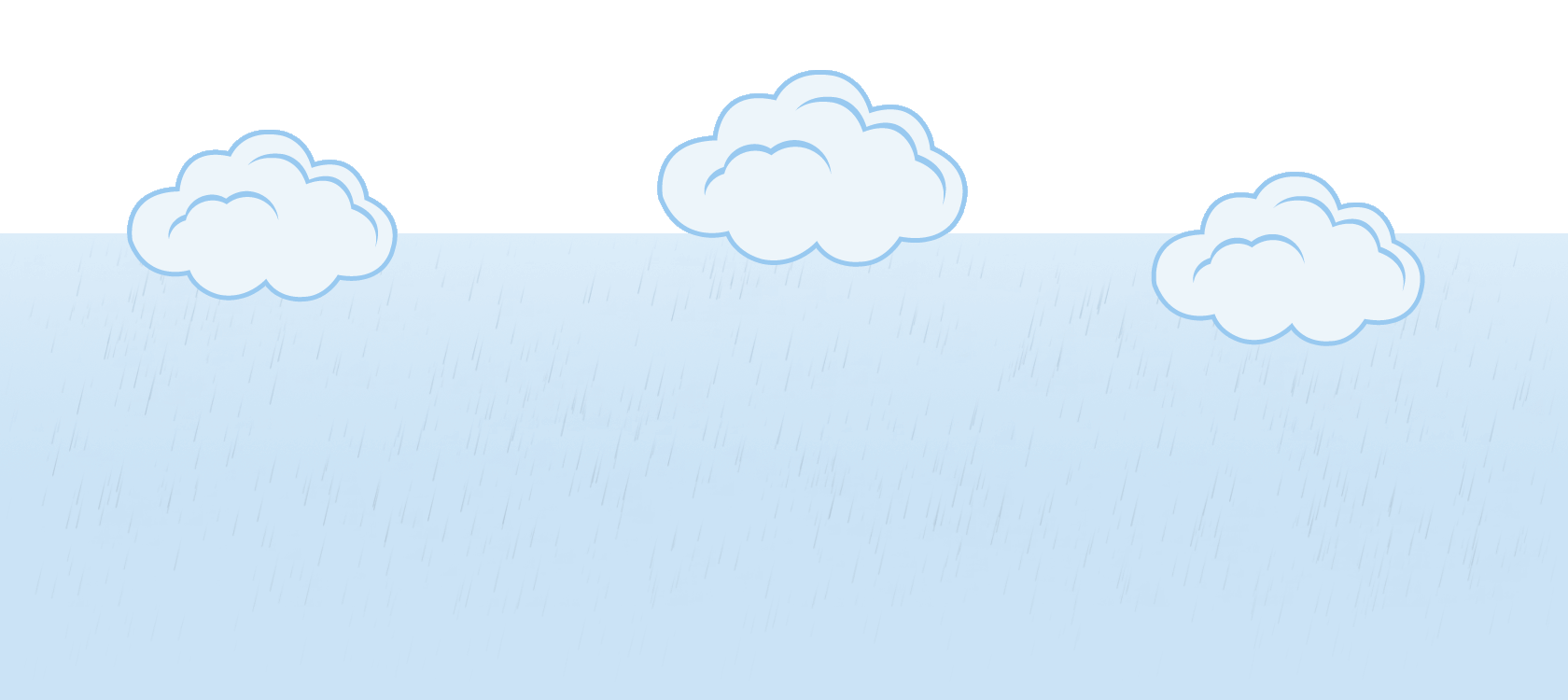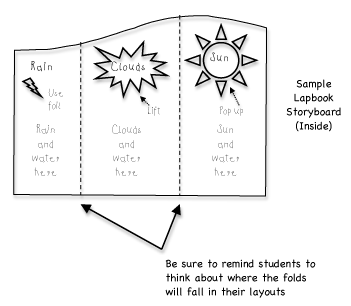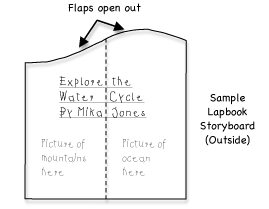This issue, I’m focusing on a particular approach to learning that will be effective for student learning of any number of science concepts, including those featured in this issue of Beyond Weather and the Water Cycle.
An essential and often under-recognized aspect of all learning is creativity. With all the focus on student achievement, children often lack opportunities to express their knowledge of classroom content with drawings and other creations. Many teachers have embraced science notebooking as a way for students to record their learning experiences and observations, and some students, like the students who created the notebooks below, take the opportunity to add their own illustrations to show their learning.
Science notebooking is an incredibly rich activity, which brings together reading, writing, reflection, and other modes of expression. We’re not going to explore it in depth here, but our sister e-zine Beyond Penguins and Polar Bears did a great job explaining how to get started with notebooking in an article.
However, science notebooking can be restricted by students’ drawing abilities. In addition, notebooks are often just exchanged between teacher and student, so valuable peer feedback and inspiration can be lost. And importantly, though children’s creativity is not usually in short supply, time in the classroom for you to support each child in the conceptualization and creation of illustrations for science notebooks can be!
Your school librarian can help you address these challenges by working with you on alternatives to science notebooking that give you instructional companionship and time to ensure that your students get the support they need. Your school librarian uses the American Association of School Librarians’ (AASL) Standards for the 21st Century Learner to guide his or her work with students. Using AASL’s Standard 4, school librarians encourage students to pursue personal and aesthetic growth in the school library by encouraging students to:
- Read widely and fluently to make connections with self, the world, and previous reading.
- Seek information for personal learning in a variety of formats and genres.
- Connect ideas to own interests and previous knowledge and experience.
- Demonstrate motivation by seeking information to answer personal questions and interests, trying a variety of formats and genres, and displaying a willingness to go beyond academic requirements.
- Interpret new information based on cultural and social context.
I’m sure that as you’ve looked around the issues of Beyond Weather and the Water Cycle, you’ve noticed our emphasis on making interdisciplinary connections and encouraging reading and writing, just like the AASL Standards suggest. School librarians and teachers both know that the power of science learning isn’t only in taking in information; it’s also about interpreting information and expressing it to others.
With the help of your school librarian, you can work together to build on the benefits of science learning through notebooking and lapbooking!
What Is Lapbooking?
Many educators already know that science notebooking is an excellent strategy to connect inquiry learning to literacy and writing. Lapbooking is an extension of science notebooking that adds the variety, interactivity, and personalization of scrapbooking. The Lapbooking 101 blog describes it as:
…an inexpensive portfolio or collection of mini-books, flaps, and folded display material, that provides interactive space for drawings, stories, graphs, graphics, timelines, diagrams, and written work, from any topic, unit study, book you choose, gathered, glued, and creatively displayed in a coloured standard sized cardboard folder, often folded in a “shutter-fold” that fits in your lap.
For example, a lapbook about the water cycle might begin with a cover that looks like this:
In the lapbook below, the creator (who is also the learner!) used pockets affixed to the page, pictures cut from worksheets and coloring books, and interactive pieces made from different colors of construction paper to illustrate the key points of precipitation. Users of the lapbook are encouraged not just to read about rain but also to manipulate objects like the umbrella pictured below.
Be sure to check out the entire rain lapbook in this this Flickr set by jimmiehomeschoolmom!
Getting Started with Lapbooking
It’s easy to get started with lapbooking. The elements for a lapbook are probably already in your classroom! File folders form the base. Construction paper can be used any number of ways – for pockets which hold additional creations, as in the lapbook featured above, and for flaps that can be flipped up or out to display information. Children can also attach illustrations that they create or cut from worksheets and magazines and include explanatory text for each of the items, giving readers an idea of sequence or coherence. Scissors, markers, crayons, removable glue, and removable tape are also must items for lapbooking!
Once your supplies are ready, make sure students are familiar with the idea of a lapbook. You might want students to see this collection of lapbooks, which shows the many different ways lapbooks can be constructed.
Then, it may be helpful to have students plan the layout of their lapbooks using a storyboard-like structure. A storyboard will help to ensure that students think about the important concepts. You can use a template for the lapbook layout, but if possible, let students use their own judgment and creativity to develop their own layouts. The storyboard can be folded like a window shutter so that the cover opens to each side to reveal the contents, as in the example below, or created in file-folder format, with a single cover flap opening.
For example, a student might draw storyboards for a lapbook about the water cycle that look like these:
Although lapbooking can be used at the end of a unit for students to demonstrate what they learned, it can also be used during a unit for students to record their learning “as it happens,” much like they would do in science notebooking. For this application, you won’t need a storyboard, but you will likely need to encourage students to be creative about how they add or rearrange items (hence the removable tape or glue) if they begin to run out of room in their lapbooks!
How Can Lapbooking Be Used in the School Library?
Aside from the obvious benefits to co-teaching with your school librarian, conducting your lapbooking activities in the school library also gives you an opportunity to connect time in the library to time in the classroom.
Using the school library for lapbooking has other educational benefits as well. A study in Michigan (Mardis and Hoffman 2007) showed that when students have access to school libraries rich in visual materials like magazines, reference books, and databases, the students also tend to be strong science learners.
Work with your librarian to use the many offerings of the school library collection to make your lapbooking projects visually appealing and exciting. When lapbooking is used with school library activities like learning to use reference books or online encyclopedias, it can be a powerful way to nurture student creativity and promote aesthetic appreciation for artistic expression. Students can use pictures in books as inspirations for their illustrations, cut articles and photos out of newspapers and magazines, and print photos from approved online sources to enhance their creations.
The school library’s space lends itself to a number of activities that will enhance the use of your lapbooks. Your school library probably also has lots of tables and room to spread out—ideal for active lapbookers!
Your school librarian can organize a Lapbook Fair in which lapbooks from various classes can be displayed and receive recognition for categories like “best illustration” or “most interactive.” Because the bases for lapbooks are file folders, lapbooks are easy to organize, collect, and exchange. A box or frame for hanging file folders is a great portable tool for keeping lapbooks at hand.
Because lapbooks are personally designed and created, they are great tools for differentiation. When used along with or in addition to science notebooks, lapbooks give opportunities for learners with a range of reading, writing, and drawing skills to combine text, pictures, and illustrations to show what they know.
When you lapbook with your school librarian, you have the camaraderie, space, and time to take the activity in a number of enriching directions. Lapbooking is versatile and creative–the only limits are your students’ imaginations!
Editor’s Note: Want to add lapbooking to the activities found in this issue of Beyond Weather and the Water Cycle? Students might read our Feature Story, Plants Need the Perfect Place and create lapbooks about plant adaptations, or add a lapbook to any of the science lesson plans highlighted in this issue.
More Lapbooking Information
Just call me Jamin! Our Lapbooks
This section of a homeschool blog contains many examples of lapbooks.
References
Lapbooking 101. What Is a Lapbook? Retrieved May 12, 2011 from http://lapbooking.wordpress.com/lapbook/.
Mardis, M.A. and Hoffman, E.S. 2007. “Collection and Collaboration: Science in Michigan Middle School Media Centers.” School Library Media Research, Vol. 10. Retrieved May 24, 2011 from http://www.ala.org/ala/mgrps/divs/aasl/aaslpubsandjournals/slmrb/slmrcontents/volume10/mardis_collectionandcollaboration.cfm.
Marcia Mardis, EdD, assistant professor, College of Information Science, Florida State University, wrote this article. Marcia is a former school librarian, school administrator, and educational digital library director. Email Marcia at beyondweather@msteacher.org.
Copyright May 2011 – The Ohio State University. This material is based upon work supported by the National Science Foundation under Grant No. 1034922. Any opinions, findings, and conclusions or recommendations expressed in this material are those of the author(s) and do not necessarily reflect the views of the National Science Foundation. This work is licensed under an Attribution-ShareAlike 3.0 Unported Creative Commons license.









